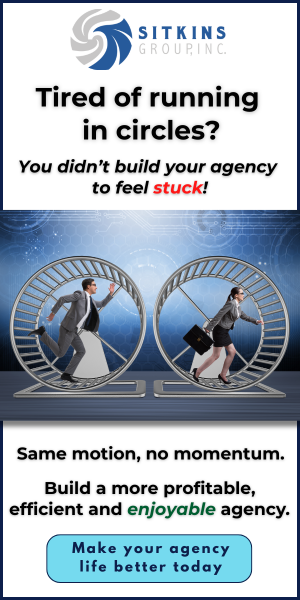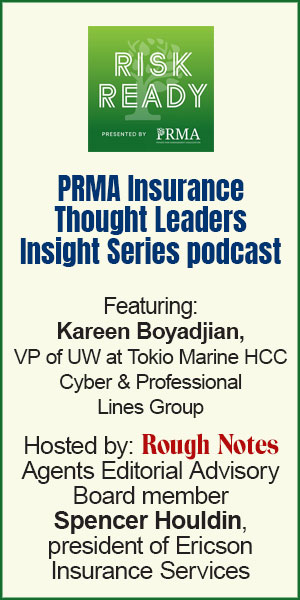Eight key elements to create
the ultimate independent agency
[We] have discovered [that] eight key business practices …
will enable any agency to create and sustain an extraordinary organization.
By Cheryl Koch, CPCU, ARM, AAI, ACSR, AFIS, and Mary Belka, CPCU, ARM, ARe, RPLU, CIC
In our consulting practices, we have the privilege of working with some of the finest agencies in the country. In examining what sets these agencies apart and allows them to achieve substantially better results than their competitors, we have discovered eight key business practices that we believe will enable any agency to create and sustain an extraordinary organization.
- Know your numbers. In the best-run agencies, senior management constantly monitors several critical measurements to determine the financial health of the agency. The traditional measures, such as EBITDA (earnings before taxes, depreciation and amortization) are certainly still relevant, especially when an agency may be sold, but those “big picture” numbers don’t necessarily help the agency spot trouble areas before it’s too late. We like to look at the following data:
Measures of Productivity: Revenue handled per account manager—including all “assistants,” is simply total commission income (with or without fee income) handled by each account manager. Many factors affect this number, some of which are discussed below; the agencies are able to move the needle on this metric.
In this market, it is essential to measure account retention, not just revenue retention. Rate increases will cause the agency’s revenue per account to improve, but account retention may be on the decline. Preservation of accounts through cross-selling is more important than ever.
An ancillary measurement, therefore, is number of policies per account. The best agencies have managed to push that number above four or five, which means they are maximizing their revenue per relationship, an important component of profitability. Monoline accounts kill productivity—and profitability.
Measure of Profitability: Cost of handling each account. It is important to determine whether accounts are actually costing the agency more to handle than the gross revenue they generate. We encourage agents to determine their “high net” and “low net” accounts. We have a simple calculation that allows an agency to compute the “cost of time” in the agency [Annual total labor cost (including benefits) divided by 100,000=average per minute cost of agency time. This can be further divided by the total number of employees to determine average cost per person.], and then apply that cost to the amount of time required to handle the various transactions on each account. Extraordinary agencies increase or eliminate those accounts that do not produce the agency’s targeted profit margin.
- Always wear your recruiting hat. Our workforce is “graying,” with the average age of agency owners well over 50. Although not a lot of data exists, we believe the average age of an agency’s employees is very close to that age as well.
The best agencies:
Recruit high school and college students and provide them with internship opportunities
Utilize true mentorship programs for new hires, which improves employee retention and success rates
Recognize that the new generation of workers cannot be recruited, rewarded or retained with 20th century business practices
Implement diversity initiatives to ensure that their workforce of the future reflects their customer demographics
Generation Z—those born between 1997 and 2012—are often referred to as “the zoomers” because they are the first truly digital natives. They now represent about 30% of the workforce, and they expect training, education and growth opportunities and will easily leave those employers who cannot or will not provide them.
- Invest in your people. The best agencies consider training an investment, not an expense. Sadly, the manager at the local Chick-fil-A probably received more early-career training than some of your employees, and yet the consequences of making a mistake aren’t nearly as high. Structured programs that will teach account managers how to manage their incoming tasks, prioritize their work, and provide excellent customer experiences are critical. A commitment to lifelong learning is vital to your continued success.
Once you’ve found and trained the right people, you must then structure compensation that is appropriate and reward the behaviors you desire. The following metrics should be considered when structuring account manager compensation plans:
Amount of revenue handled
Account retention rates
Customer satisfaction ratings
Timeliness, error ratios, and efficient use of technology
Adherence to procedures
Ongoing professional education
- Adopt “beyond best practices” processes and procedures. The most profitable agencies realize that everything we do is a structured process—from sales to service to support. Many of the things we do in the name of service add nothing to either the client’s experience or our bottom line, while critical tasks are bypassed for “lack of time.” Objective analysis of all processes leads to increased levels of service and profitability.
Formal, written procedures are necessary to ensure operational efficiency, provide training to new employees, and reduce the likelihood of errors and omissions claims. Without an “agency way” of doing things, people usually create their own system for account handling. The resulting lack of consistency leads to chronic backlog, increased potential for errors and omissions claims, and training challenges.
Most outstanding agencies have segmented their commercial lines business into complex and non-complex accounts to maximize profitability by adhering to a specific profile:
No producer involvement—or compensation
Pre-qualification is key. Standard risks only. No excess and surplus lines (E&S) placements
Avoid high service, low net accounts. Certificate activity kills profits. All certificates should be issued by the insured through portal software. That also applies to complex accounts
No more than three or four markets; and no extensive remarketing for renewal business—two markets at the most
Direct bill only; and all policies must be forwarded directly to the client by the carrier
Write accounts—not policies
- Harness the power of technology. Extraordinary agencies have taken control of their “techstack” and eliminated virtually all paper, even that coming in the door. If you are using your agency management system and other systems properly, and have consistent procedures and training, producers and account managers can work from anywhere.
Agencies that are maximizing their investment in technology also have flatter organizations. The hierarchical structure so popular in some agencies, where account managers have assistants—and the assistants have assistants—creates inefficiencies as items are parsed out among various associates.
Handoffs are unnecessary in an automated environment, which presumes that the person who initiates a transaction completes it, and may also lead to increased E&O exposures. Great agencies eliminate inefficient processes, rather than attempt to “automate” or outsource them.
- Partner with like-minded businesses. Carriers who truly share an agency’s commitment to long-term relationships, stable markets, and competitive products—in both soft and hard markets—should get a substantial share of the business they wish to write. The top agencies in the country have reduced the number of companies they represent, favoring an approach that allows them to have better, closer and more profitable relationships with a limited number of carriers that share the agency’s values and business philosophy.
Great agencies also partner with various centers of influence, such as banks, attorneys, CPAs, wealth managers, and others to create a constant pipeline of business opportunities and prospects. They become allied with firms that can provide certain products to the agency’s existing clients that the agency does not wish to provide itself, e.g., employee benefits, surety, loss control and risk management services. Being able to offer the client a one-stop approach usually results in higher retention for the agency and improved profitability per account.
- Create and sustain a true sales culture. Insurance is the only industry where salespeople are encouraged to quit selling while still on the job. It’s called renewal commission. When the differential between new and renewal commission rates is small, a producer who has built a book of business can shift his or her efforts to retaining that business versus selling new accounts. This often results in producers who become their own account managers.
What gets rewarded gets repeated—these generous commission schedules send a message to the producer that renewing business is of equal importance to selling new accounts. It should be the account managers’ responsibility to do the day-to-day transactions on the account and handle the majority of renewal tasks.
If you are lucky enough to find a “hunter,” don’t turn him or her into a “farmer” with a compensation program that rewards account maintenance over new sales. And if your hunter turns out not to be one at all, you must be ready to make the tough decision and cut your losses.
- Have a plan. The most significant difference between good and great agencies is that everything starts with meaningful strategic business planning. Everything we’ve discussed here starts with a plan. Many agency owners know what must be done to take the agency to the next level, but not all of them are able to stay the course and provide the leadership necessary to actually get there.
Execution makes all the difference. We have every confidence in the ability of independent insurance agents to create the ultimate agency since we continue to observe it first-hand.
The authors
Cheryl Koch is the owner of Agency Management Resource Group, a California firm providing training, education and consulting to producers, account managers and owners of independent agencies. She has a BA in Economics from UCLA and an MBA from Sacramento State University. She has also earned several insurance professional designations: CPCU, CIC, ARM, AAI, AAI-M, API, AIS, AAM, AIM, ARP, AINS, ACSR, AFIS, and MLIS.
Mary M. Belka is owner and CEO of Eisenhart Consulting Group, Inc., providing management and operations consulting to the insurance industry. She also is an endorsed agency E&O auditor for Swiss Re/Westport. A graduate of the University of Nebraska, Mary holds the CPCU, ARM, ARe, RPLU, CIC, and CPIW designations.





